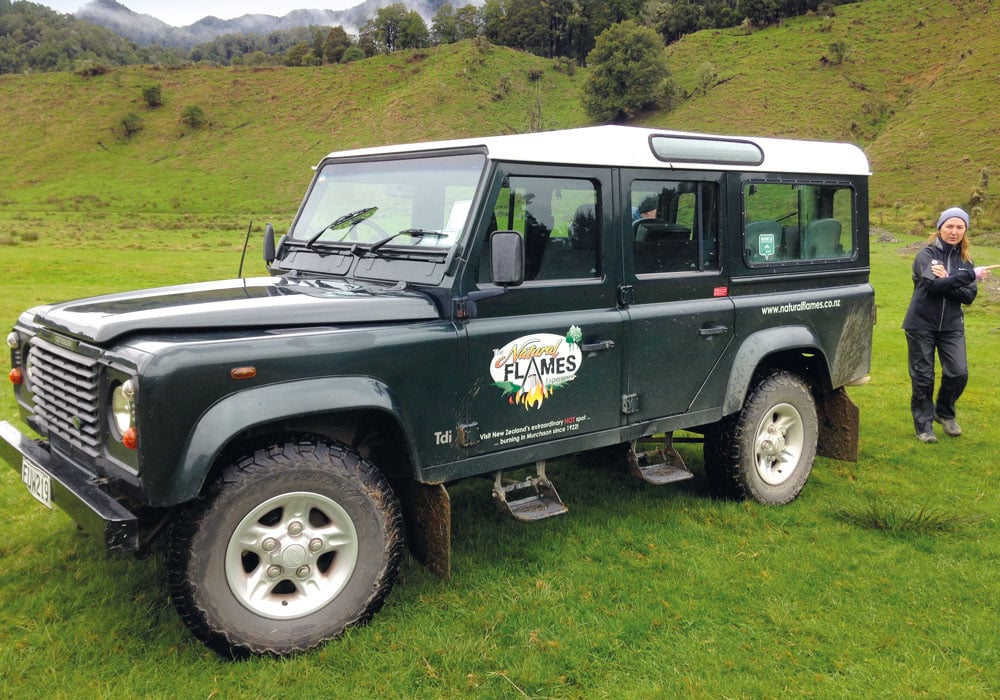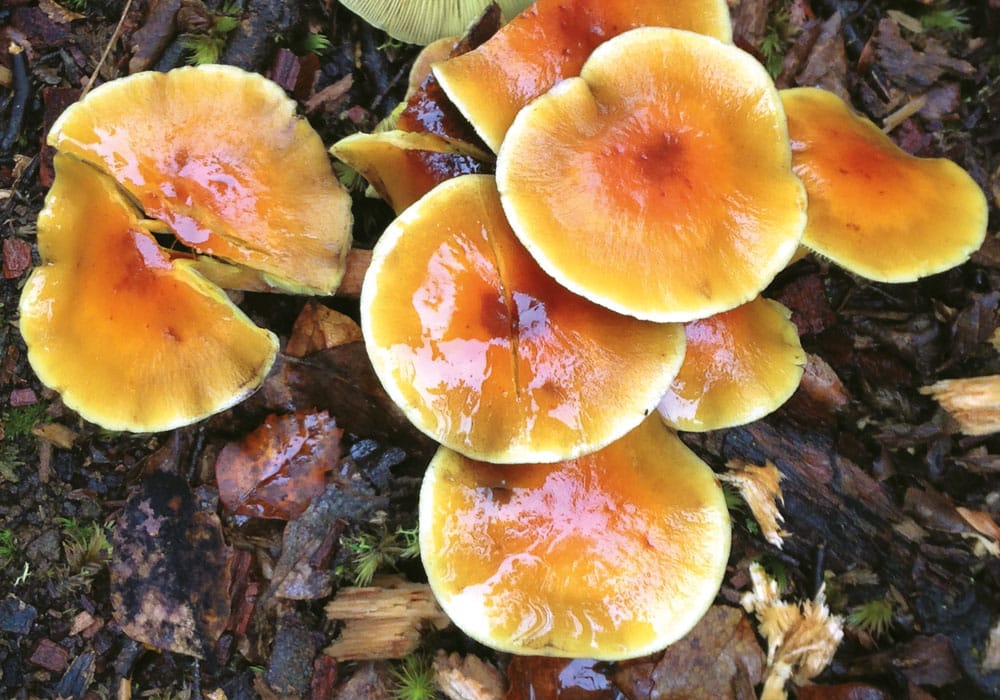Among the beech forest just outside Murchison, Eleanor Hughes discovers a flash of orange between the green foliage.
One hundred years ago, two blokes hunting in the bush came across bubbling mud. A match was tossed on it. Flames ensued. They’ve been burning almost continuously ever since.
Having driven 120km south through torrential rain from Nelson, we were worried our tour to see these flames ourselves wouldn’t actually happen. Happily the sky was clearing by the time we arrived in Murchison, and Shelley, our guide from The Natural Flames Experience, met us not long after.
We joined her in the company’s Land Rover, and set off on a 30-minute drive heading southwards on State Highway Six (which leads to Westport 100km away) alongside the fast-flowing Buller River. A right took us onto the gravelled Mangles Valley Road beside the narrower Mangles River and into Mangles Valley, flanked on the left by bush-clad hills. It opened up to farmland the further we drove. On Blackwater Road, I got a glimpse of Blackwater River – one of three rivers within a few kilometres
of each other, named because of their dark waters.
We came to a stop on the roadside at a small wire cage, perhaps a metre square. Inside were a couple of bolted closed, rusty-red metal pipes with a gauge on top. “This is a capped oil well,” Shelley informed us. “The gauge is maxed out. It’s under pressure.” She explained that on occasion, before the cage was erected, locals would open the cap, causing oil to spurt out above the road and over the river.

Possum plucking
Leaving the well behind, we reached the end of the road and the entrance to Blackwater Farm, a low intensity farm, farming beef, sheep and red deer. The Wapiti stags looked enormous, even from a distance as we followed the farm road. At a shed, seven, very furry, dead possums hung awaiting plucking in the nearby plucking machine where a rubber paddle pulls off the fur, which is then blown into a caged net. In winter, when possum fur is thick, it’s possible to obtain a kilogram of fur from ten of them. Fur was selling for $130/kg. The naked possum becomes food for the farm dogs. Slightly further down the road, where a large farm shed now stands, was the site of the 1970s 142ft-high oil rig. Led by a Texan with an Argentinian crew, drilling took place for six months, 24 hours a day, seven days a week. A depth of 10,000 feet was reached before money ran out, with $800,000 spent on exploration.
Walking the track to the flames
Reaching the edge of the farm property, overlooked by a herd of deer camouflaged on a brown hill, we came to a halt. Forested ranges peaked above low cloud, but thankfully the rain had stopped. We were on foot from here. Heading through a gate onto DOC land, we each picked a walking pole from the variety hanging on the fence and followed Shelley. With Blackwater River on our right, the track weaved between towering silver and red beech, a few Kahikatea rising above them. It opened up to grassed land then led back into beech forest.

Bright green sphagnum, lush and velvet-looking covered fallen branches and the forest floor gave the appearance of being newly carpeted. In the stillness, I wouldn’t have been surprised if a fairy had flitted from one of the numerous green mounds that looked like miniature hills amongst the trees. Sphagnum was harvested on the West Coast in the ‘70s and ‘80s, mainly for horticultural use. Apparently it’s also been used in incontinence pads due to its absorbency and sponginess!
Despite heavy rain during the night and all morning, our boots barely got wet when we crossed the river at a point around a metre wide, and the second time where it’s maybe two metres across. This was due to cemented rocks in the river bed making excellent stepping stones. The tree roots were a little slippery; a rope to hold onto helped at one spot, but overall this is an easy walk. Mauve, orange, deep purple and white-spotted red fungi give delightful splotches of contrast to the green and brown ground landscape.
A glazed-looking white mushroom was slimy to touch, a white one randomly grew from a hollowed trunk at head height.
Beech Dew Honey
Blackened beech trunks are numerous, the result of sooty disease that grows on honey dew excreted by scale insects. Shelley pointed out fine hairs about five centimetres long that were attached to the trunks like solitary strands of cobweb, a tiny droplet of honeydew on the ends. The hair comes from the anal gland of the scale insect, which feeds on the trees’ sap. Unable to process it all, the insect excretes the sugars that are an important source of food for moths, bellbirds and tuis. The honey dew also attracts wasps, which becomes problematic as their numbers increase and they consume up to 90% of the honey dew. Honey bees feed on it too, taking it back to hives and making beech dew honey. A speciality of Murchison, it’s produced commercially.
An hour and a quarter’s fairly level walking brought us to a slight rise. “Wow!” I exclaimed, as I spotted a flash of orange between the green foliage.
The Flames
A few more steps and there, surrounded by ferns, flames burned in a brown and blackened dirt alcove. According to Shelley, we had come on a good day, and the flames were dancing quite high.
The flames have only gone out a couple of times over the century, still burning even when water is running through them after a heavy deluge. Cocooned amidst the cool bush, we sat on a log enjoying their warmth, a friendly robin flitting up to rest next to us, hopping at our feet. Shelley stirred the dirt up at the edge of the flames. More ignited. Setting up a metal tripod over them with a heavy hotplate atop, she cooked us perfect, golden brown pikelets that we drizzled with dark beech dew honey that tasted like maple syrup. With a hot chocolate as well, I could have sat there all day… except rain started pattering.
Decades ago locals picnicked at the flames, referring to them as ‘gas blows’. The track wasn’t visible in the jungle-like vegetation, a few jar lids tacked to trees showing the way. The trail we followed has only been formed in the last 10 years through constant use, but the vegetation is still dense.
Protected by the forest canopy, the rain didn’t hinder us on our return walk, which took around 50 minutes, the colourful fungi not distracting us as it had on the way there!
Back in the Land Rover, Murchison bound, Shelley told us of the Murchison earthquake, pointing out giant boulders lying at the foot of high hills, dislodged by landslides triggered by the 7.3 quake. The tremors were felt all over the country and many people were made homeless, billeted by families in Nelson while the town was rebuilt.

Murchison Tragedy
Our tour ends with the tale of the Murchison Tragedy, which made world news in 1905 and involved Shelley’s great, great grandfather, Walter Neame. It centred on a heifer, with
a distinctive white face, which Walter owned but had gone missing. Eventually spotted across the river on neighbour Joseph Sewell’s property, Neame reclaimed it. Conflict then escalated over its ownership, and the matter reached court with locals packing the courthouse to hear the outcome. In the stand, Sewell appeared very agitated and was told to go outside by the magistrate to cool off. Outside, he detonated dynamite strapped to his body and was blown to pieces. Police officers accompanying him were badly injured but survived, courthouse windows were blown out, and people injured.
Murchison was sleepy, almost deserted on our return and disappointingly, the museum was closed. I would have loved
to have discovered more of the area’s history to add to the abundance we learned on a flaming good tour.
Oil exploration around Murchison
The flames were lit in 1922 by local farmers Lewis Hingham and Allan Gardiner, who were hunting deep in the bush. Smelling gas, they returned to the spot a few days later with a pipe, and lit the match, setting the gas vents known as the Natural Flames alight, and creating the world’s only perpetually burning fire in a forest.
While five different gases are emitted by the gas blows – methane, ethane, propane butane and pentane – the flames feed on methane. And where there’s gas, there’s oil. The area has been explored for oil and gas for decades; when a farmer noticed some black seepage at the side of the riverbank, it was decided to drill for oil. A rig was built and drilling went down to 4000 feet with traces of quite good quality ‘black gold’ found but in no great quantity. The drilling bit was lost down the hole and soon after the Murchison earthquake, striking on June 17 1929, devastated the town bringing exploration to a halt.
Interest in oil was not revived until 1968 when an oil rig was brought in and set up on the back of a truck at the location we were stopped at. Drilling down 2,000 feet, oil condensate was extracted. Little was found but it got international interest. Two years later, in 1970, a massive oil rig was built further up the valley. Layers of oil were found but no reservoir from which it could be pumped – it was deemed not worthwhile. While there have been tests to see if there’s more, for the main part Murchison oil exploration has come to an end.
More information
- Naturalflames.co.nz – the approxiately 4.5-hour tour takes up to 10 people. As long as you’re agile and relatively fit, it’s doable. The oldest participant they’ve had was 92!
- visitmurchison.nz/murchison-museum – Murchison Museum is open daily from 11am – 3pm.
- See nzmca.org.nz for camping options around Murchison.








